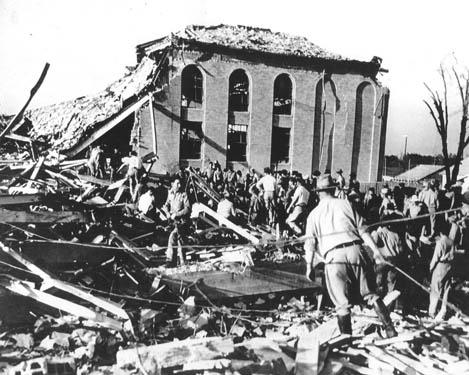This is not a drill
Do fire drills help or hinder students

Picture of New London School fire which led to an explosion where only 130 people out of the 600 staff evacuated without serious injuries.
The Pennsylvania School Code requires that public schools hold mandatory fire drills at least once a month that the school is in operation. These schools include public, charter and cyber schools. These fire drills must involve both students and teachers evacuating the building during the drill. Schools are also required to maintain fire escapes and fire extinguishers.
Fires can be devastating events that can end in damage and a tremendous loss of life. By conducting annual fire drills, schools try to ensure that all students and faculty make it out of the building with the least amount of casualties. Although these drills are great in theory, many students, like anything else, don’t take them seriously.
Many students joke around and take these drills as a time to socialize with friends outside of the classroom. With all of this in mind, it truly leads to the question of whether or not drills are worth the time, or if they just lead to students not taking actual emergencies seriously.
The whole idea of performing fire drills came from the major school fires that caused many casualties in the past. One of the largest in history took place on March 18, 1937 at New London School in New London, Texas where 296 people were killed. With the advancements in technology, there are now ways to battle the flames, along with ways to inform people faster that there is a fire. With practicing these drills, the overall number of casualties has gone down.
With constant increasing needs to add time to the teachers instructional time, and new topics and lessons being added to the curriculum, it’s not surprising that teachers don’t care for fire drills. Fire drills not only make students rowdy, but they also take students out of the classroom for anywhere from 10-20 minutes. Since law regulates that each school has one (10 minutes) each month (9 months) that would be at least 90 minutes wasted that could be used to learn something in class.
Most drills maintain the same scenario each time, which can lead to people not knowing what to do if a real situation occurs. For example in case of someone having a disability or handicap most students do not know what protocol to follow, or how to help someone. Another factor would be most students don’t know where to go if a route is blocked without being told. In case of an emergency, students should know exactly where to go and what to do if certain areas aren’t open.
Fire drills are not the only drills that are practiced, students also practice tornado drills, along with lock-and-teach drills. Teachers also practice what to do in case of a school shooter. Not only do students tend to not take fire drills seriously, but they also tend act similarly when it comes to tornado drills..
With all of this in mind, the question of whether or not drills help or waste students’ time still doesn’t have a solid answer. With both pros and cons to drills, it’s hard to say. One thing for sure is no matter what drill is being practiced, students should focus more on the event that could happen at any moment and how to keep their peers and themselves safe.


